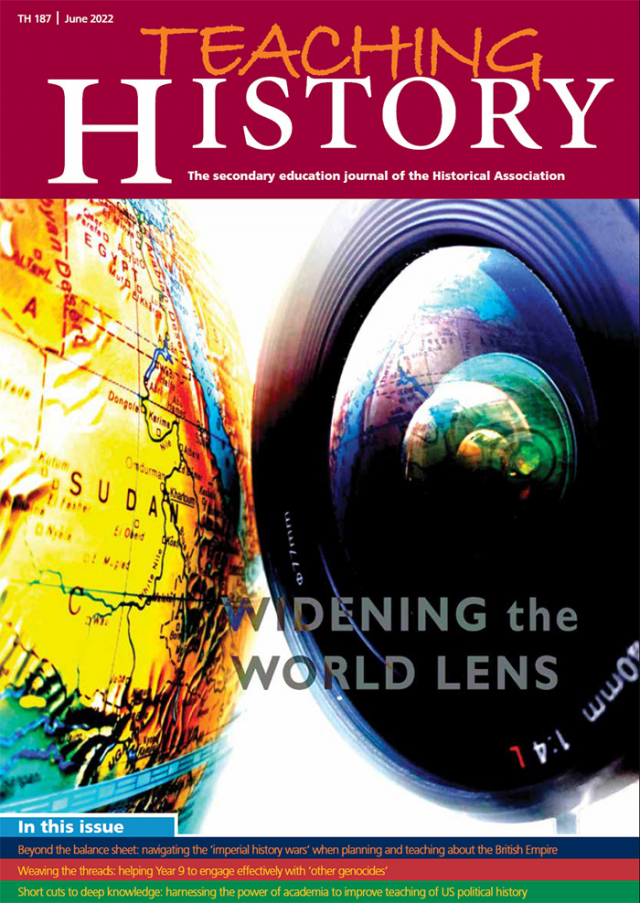Teaching History 187: Out now

Editorial: Widening the World Lens
Read Teaching History 187: Widening the World lens
Those who don’t teach history sometimes ask why it is that the work of history curriculum development is never finished. Why is it that just when a scheme of work seems to be working well, the history teacher starts to question it, to re-shape it or even to ditch it altogether? New historical questions, new scholarship, new debates or new considerations arising from conversations with the pupils themselves frequently propel history teachers back into the creative work of curricular design. Moreover, history teachers fortunate enough to be in situations where they can do this collaboratively, enjoying debate and challenge as well as the stimulus of hearing about others’ reading, certainly don’t consider this a burden. There may never be enough time, but at least the intellectual and creative work of curriculum shaping is one call on a history teacher’s time that is rarely resented.
Just one of the drivers of this steady state of renewal is the sheer enormity of world history with its infinite stories, all capable of infinite configurations into infinite, bigger stories. Any event or development, when placed in wider and wider global contexts, or viewed across longer stretches of time, can start to change its historical meaning. When we broaden the world lens, old story shapes are challenged, new patterns are illuminated and fresh questions are suggested.
In our first article, we read how Alex Benger drew on Catherine Hall’s scholarship to find a set of analytical concepts which would help his Year 9 pupils to think about colonialism on a grand scale. A further factor drove his curriculum enquiry, too. He wanted to challenge any resurgence of the moral balance-sheet approach to studying the past, and to replace it with a disciplinary one. Benger reflects on the power of Hall’s work to help pupils think about colonialism in multiple settings at once, and to do so with sharper analytic tools than mere ‘similarity and difference’.
Andy Lawrence broadens the world lens on genocide. Returning to arguments made in Teaching History 153 for teaching about modern genocides in addition to the Holocaust, Lawrence explains how he tackles the problem of limited curriculum time for achieving this. Lawrence weaves concepts and themes across Key Stage 3 so that pupils are ready for the particular contexts in which one (or more) of those other genocides occurred. In this way, he ensures that pupils are able to reflect on the causes and nature of modern genocide without being overwhelmed by the detail of unfamiliar contexts.
Eleri Hedley-Carter widens her pupils’ lenses both by using the curricular tool of ‘interpretations’ and by teaching a neglected aspect of women’s history in colonial Nigeria. Hedley-Carter was inspired by Judith Van Allen’s 1972 reinterpretation of what were once known as the ‘Aba Riots’ in 1929. Judith Van Allen’s work led to these events being restyled as the Igbo Women’s War. Hedley-Carter taught her pupils both about 1920s Nigeria and about American and global events of the 1960s which shaped Van Allen’s reinterpretation. Thus her pupils came to learn not only about a highly consequential event in Nigeria but also how and why processes of reinterpretation occur. Sam Pullan likewise shares how working with an historian transformed his practice. Working directly with historian Adam Smith, Pullan found himself looking at a once familiar source, Martin Luther King’s ‘I have a dream’ speech, with new layers of background knowledge. Together, they were able to frame a new enquiry question that would not have been possible without Smith’s broader knowledge and insight concerning the US constitution.
Verity Morgan broadened her pupils’ world lens by collaborating with a school in Ghana on a scheme of work which placed the Covid-19 pandemic in broad temporal and global contexts. Morgan sets out the rationale for the project, her detailed adaptation of a British Council resource and her assessment of the striking benefits that came from connecting her pupils with a Ghanaian perspective.
In this edition’s Polychronicon, further widening of the world lens is achieved through Rana Mitter’s helpful survey of recent historiography of China. The opening of archives relating to the Republican period (1912–49) not only reveals a complex and pluralistic social picture but also encourages new exploration continuities with and divergences from the era of Mao. Mitter also points to scholars’ growing realisation that war was a much more powerful factor in shaping China in the past century than had previously been understood.
Carroll’s focus on the use of metaphor in argument complements all the above by reminding us how disciplinary conventions and specific substantive content meet, mesh and modify one another in the construction of any historical knowledge. Carroll’s article will be useful ballast for those history teachers frustrated by having to impose generic, whole-school literacy strategies on their classes. Carroll reveals the danger of treating historical writing as a ‘trusty toolbox’ or a set of repeatable, tried-and-tested processes for explaining why things happened in history. Explaining how and why he replaced word banks with metaphors, Carroll weaves an intricate case for ensuring that the specifics of the substantive content (in this case, the Salem witch trials) and the requirements of a particular disciplinary argument (in this case, the kind of causal reasoning which involves ‘conditions’) fundamentally determine language choice and deployment. Using a wide range of scholarship on seventeenth-century witchcraft in Massachusetts, Carroll finds, to a remarkable degree, that metaphor is a fundamental tool of historical argumentation and that it has a distinctive value in capturing the patterning of events and their interplay, across time.

